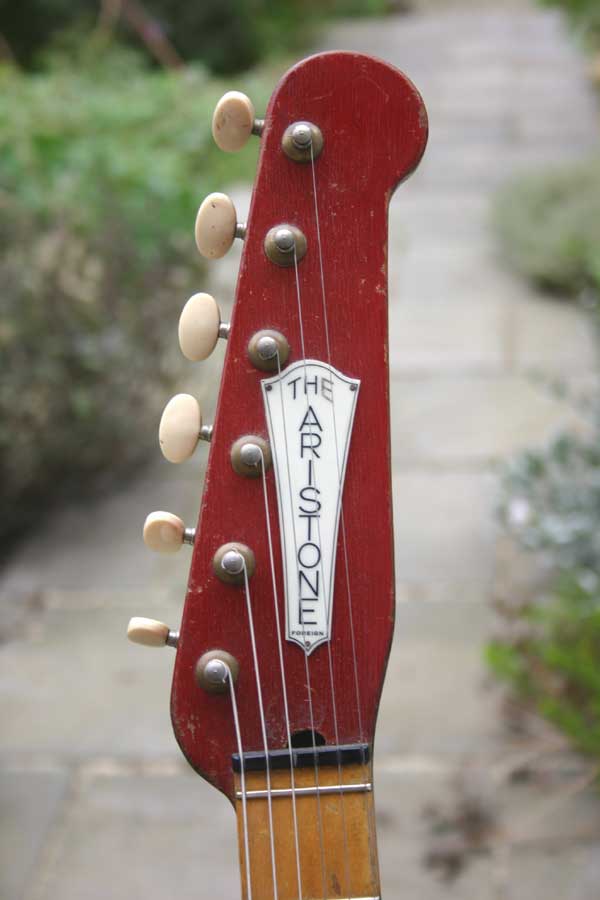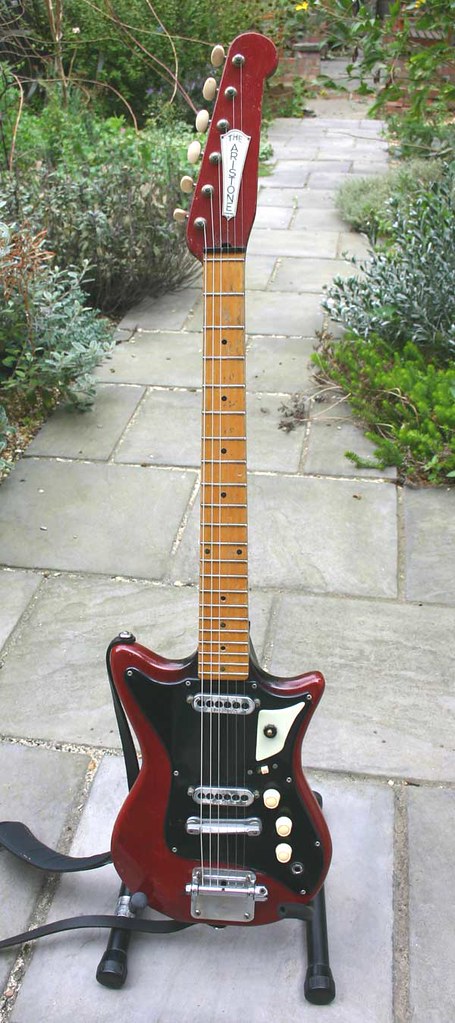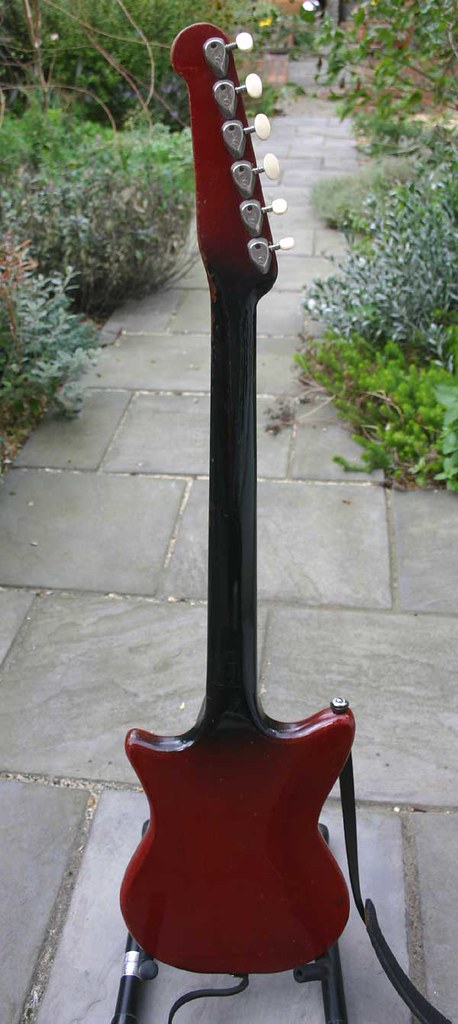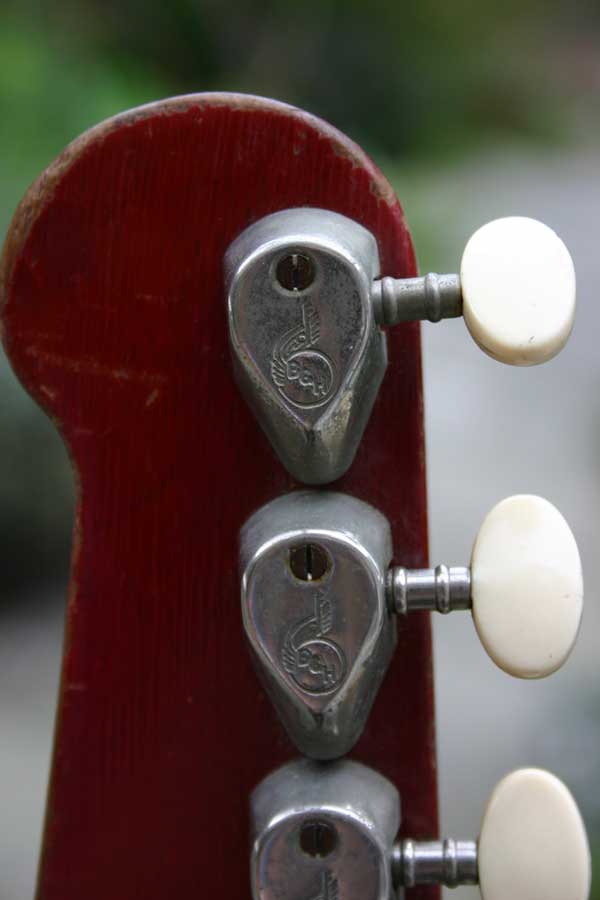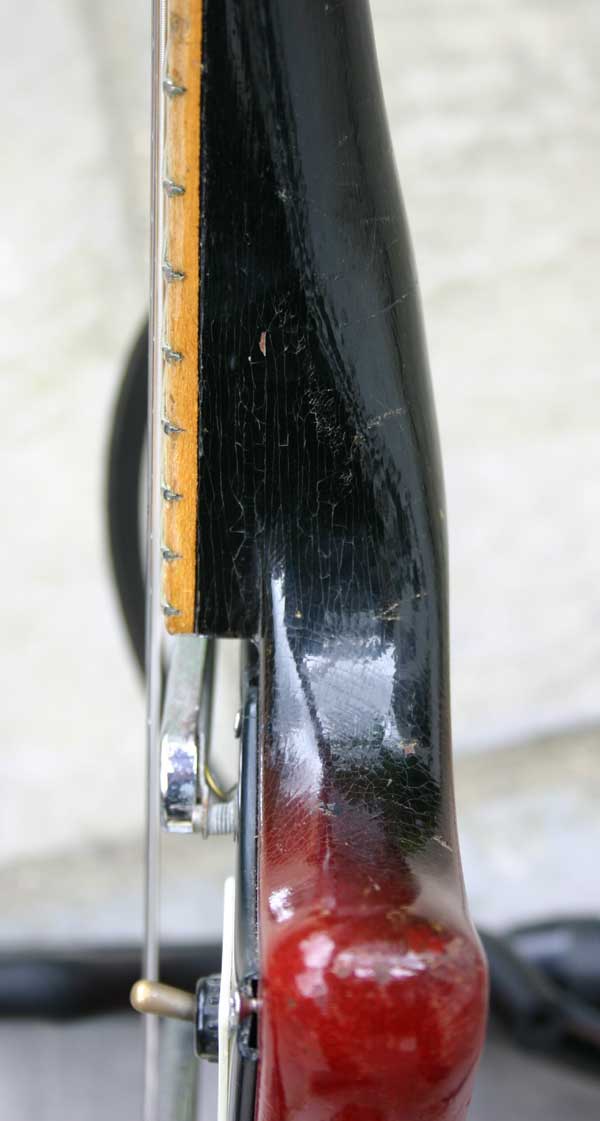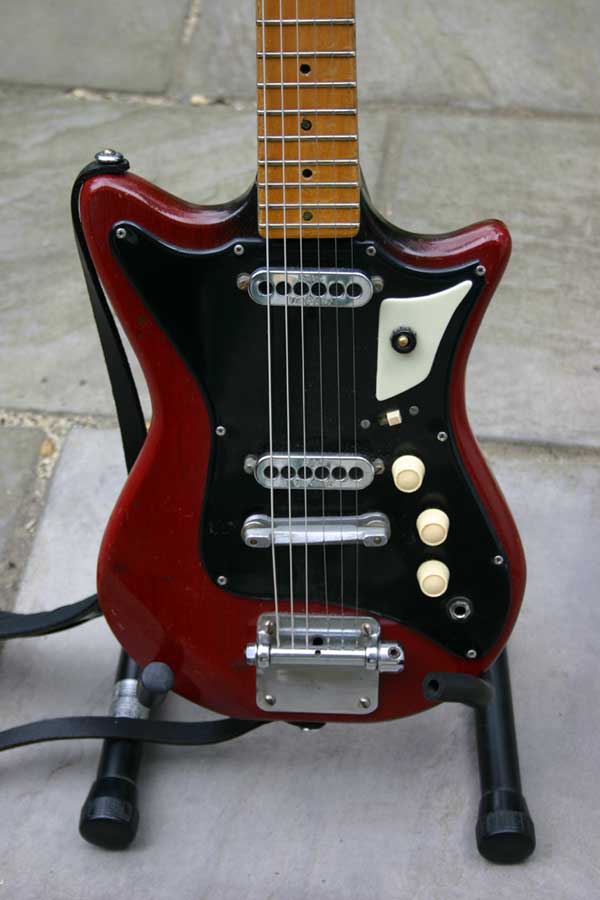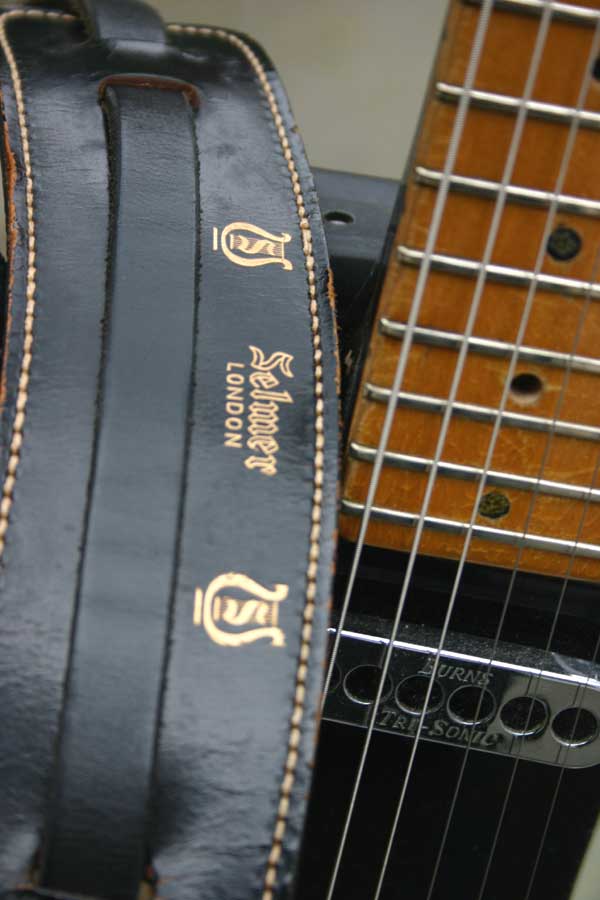One of my modest insights into the world of Ebay is that it's only good at finding things that are correctly identified. It's like cataloguing; one the places where parts of my job extend into my real life. If someone is selling an original Fuzz Face and they call it that in the main description, lots of people will find it/see it/bid on it. But if it's described as a 'round grey guitar peddle', a lot less people will see it. This was how I got the Silvertone/Valco - interest in Supro-type guitars was at a generally lower level than now, and someone checking a Silvertone listing would probably be looking for a Danelectro, and pass on it - I recognised it as a Valco and got it cheap. Look for the vague descriptions, and there are bargains if you don't mind wading through the crap. I got the Burns the same way.
People with an interest in guitars of the early '60s would recognise it as a Burns, but the name on the headstock is "The Aristone", so that was the main Ebay description term. Deal! Aristone were a London company who had been making banjos and ukeleles and archtop acoustic guitars since the 1930s. I've seen one other electric guitar with the same headstock logo, a late 50s semi-acoustic, on sale for a huge sum at Andy's Guitar Workshop in the year they went into liquidation. How Aristone were related to Jim Burns is a mystery, but there's no sign of any other markings, and in every other respect it's a straight-up 1960 Burns Sonic - complete with maple fretboard, white plastic knobs, army surplus 3-way switch and first-stab trem system. My only guess is that if you're starting out trying to sell guitars and nobody knows your name, you might strike a deal to use a bigger name, even if they are best known for banjos. A lot of companies were testing the water of the future beat tidal wave, and Aristone must have been one of them. Whatever the arrangement was, it didn't last. The only other clue is that the word 'foreign' appears at the bottom of the logo - maybe it was an export model.
The tuner covers reveal another unusual detail. Guitar nerds will recognise these as Van Gent tuners from the Netherlands, but they are also stamped with the logo of their British distributors, Boosey & Hawkes. I've seen these on some 1950s Grimshaw guitars online, but mostly they are plain.
It's a funny looking thing, badly designed in some ways and brilliant in others. The major problem is the weight of the neck/body joint versus the tiny, admittedly kind of silly-looking body. I had a friend in a band in the grungeful early 90s. He was a very small person and my first thought seeing him playing it was that he must have chosen it to match his stature. I was plain wrong (and probably size-ist), but with this design, how could it be anything other than neck-heavy? This photo also shows up the brittle hollow scratchplate and military grade switch.
You see some examples with the strap button moved to the lower bout, to move the centre of gravity, but this one has stayed as Mr Burns (tee hee) intended. Balance problems come into perspective when you plug it in - theses are really great pickups, maybe even better than the Valco single coils I love, so why not just sit down if its a problem? They really bite - a very punky spiky beat sound, but with a smoother mid-range and a good growl in the bass. Yay! This the best guitar for fuzz ever.
I mentioned the trem system above and you might be thinking 'what trem system?' I took the 'pat. pending' arm off and disabled it to get the action a bit lower, but the pieces are all safe. It didn't work too well in the first place. I also reversed the polarity of the bridge pickup, for more usable sounds. Originally the pickups were out of phase, which made for a strange hollow sound in the middle position that I didn't like. I changed it, but to me it's an improvement. It's been through the wars a bit, so I don't mind making a few positive alterations. To me it's still a working instrument.
One last thing I should mention is the Selmer strap. This was another ebay find - it didn't come with the guitar, but it's a good match. American collectors call this kind of thing 'case candy'. I could never use that expression, but I don't have the case either.
Monday, October 6, 2008
Burns Sonic guitar, 1960 ("The Aristone")
Sunday, October 5, 2008
Tim Escobedo's Uglyface - a modern classic!
So mainly I like old stuff, but one reason I got into DIY was to discover new sounds. The Uglyface is one of THE classic DIY pedals, designed by an unassuming and generous experimenter, Tim Escobedo. I've built four of his pedal designs, and an ambitious double synthstick built into a guitar (more on this later). I think he came up with it in 2003. A lot of people on DIY Stompboxes were raving about it, so I built mine in 2006. By this time my Dymo tape aesthetic had reached the mature stage, although I probably should have the knobs away from the footswitch.
 In the DIY effects pedal world, there are clones or rare pedals, and there are home projects that become retail Product, and there are pedals that exist only in the pure DIY realm, because they are too weird or horrible-in-a-good way to have mainstream commercial potential, like the Uglyface. Guitarists are conservative as a group (= market). Tradition weighs heavy on their shoulders, and their music is boring. Most of them don't want a pedal that makes their guitar sound like a raygun. I didn't record this clip (Tim did), but it gives you a good idea of what this thing does. Here's another , from homewrecker/runoffgroove - if this doesn't get your attention, then we can't be friends.
In the DIY effects pedal world, there are clones or rare pedals, and there are home projects that become retail Product, and there are pedals that exist only in the pure DIY realm, because they are too weird or horrible-in-a-good way to have mainstream commercial potential, like the Uglyface. Guitarists are conservative as a group (= market). Tradition weighs heavy on their shoulders, and their music is boring. Most of them don't want a pedal that makes their guitar sound like a raygun. I didn't record this clip (Tim did), but it gives you a good idea of what this thing does. Here's another , from homewrecker/runoffgroove - if this doesn't get your attention, then we can't be friends.
 I built it from scratch on plain board with holes, called perfboard, or just perf. This is one of several building methods, and it's probably my least favourite. I don't use it much, but there was (and is) a perf layout of the Uglyface at homewrecker.com. It was one of my first builds beyond the basic fuzz circuits and I didn't really know what I was doing exactly at the time, but I put it together paint-by-numbers style. it took a while to get it right, but I got there in the end. The trickiest part for me was the Vactrol, which adds the envelope follower wah-type sound. I colour coded the wires carefully and made notes, so I wouldn't get too mixed up, and left myself plenty of space.
I built it from scratch on plain board with holes, called perfboard, or just perf. This is one of several building methods, and it's probably my least favourite. I don't use it much, but there was (and is) a perf layout of the Uglyface at homewrecker.com. It was one of my first builds beyond the basic fuzz circuits and I didn't really know what I was doing exactly at the time, but I put it together paint-by-numbers style. it took a while to get it right, but I got there in the end. The trickiest part for me was the Vactrol, which adds the envelope follower wah-type sound. I colour coded the wires carefully and made notes, so I wouldn't get too mixed up, and left myself plenty of space.
 So what is it? The clips should tell you all you need to know, but if I had to describe it, I'd say it's kind of like a fuzz, but instead of just taking the wave form from your guitar and amplifying/clipping it to make a square wave (like most fuzz/distortion boxes), the Uglyface takes your signal in on one side, but what comes out of the other side is a whole new signal that tracks the changes in a fuzzed out version of the input signal, but can't follow it exactly, or reproduce its complexity, so what you hear is a big wall of glitchy, synthy guitar noise. I love it. The basic envelope follower makes it even less guitar-like. Certain settings will get you the Star Wars thing going.
There are a couple of ther DIY circuits that apparently have some similarity to this floating around - John Hollis' Crash Sync /Auto Crash and the 4ms Noise Swash, but this is the simplest to build, and best documented. There have been stripboard layouts and a modification or two in the last couple of years. Tim Escobedo rules. I can't help forming mental images of people I've never seen; I imagine Tim has short-ish dark hair and a full but closely cropped beard, a bit like David Fair from Half Japanese perhaps.
So what is it? The clips should tell you all you need to know, but if I had to describe it, I'd say it's kind of like a fuzz, but instead of just taking the wave form from your guitar and amplifying/clipping it to make a square wave (like most fuzz/distortion boxes), the Uglyface takes your signal in on one side, but what comes out of the other side is a whole new signal that tracks the changes in a fuzzed out version of the input signal, but can't follow it exactly, or reproduce its complexity, so what you hear is a big wall of glitchy, synthy guitar noise. I love it. The basic envelope follower makes it even less guitar-like. Certain settings will get you the Star Wars thing going.
There are a couple of ther DIY circuits that apparently have some similarity to this floating around - John Hollis' Crash Sync /Auto Crash and the 4ms Noise Swash, but this is the simplest to build, and best documented. There have been stripboard layouts and a modification or two in the last couple of years. Tim Escobedo rules. I can't help forming mental images of people I've never seen; I imagine Tim has short-ish dark hair and a full but closely cropped beard, a bit like David Fair from Half Japanese perhaps.
 In the DIY effects pedal world, there are clones or rare pedals, and there are home projects that become retail Product, and there are pedals that exist only in the pure DIY realm, because they are too weird or horrible-in-a-good way to have mainstream commercial potential, like the Uglyface. Guitarists are conservative as a group (= market). Tradition weighs heavy on their shoulders, and their music is boring. Most of them don't want a pedal that makes their guitar sound like a raygun. I didn't record this clip (Tim did), but it gives you a good idea of what this thing does. Here's another , from homewrecker/runoffgroove - if this doesn't get your attention, then we can't be friends.
In the DIY effects pedal world, there are clones or rare pedals, and there are home projects that become retail Product, and there are pedals that exist only in the pure DIY realm, because they are too weird or horrible-in-a-good way to have mainstream commercial potential, like the Uglyface. Guitarists are conservative as a group (= market). Tradition weighs heavy on their shoulders, and their music is boring. Most of them don't want a pedal that makes their guitar sound like a raygun. I didn't record this clip (Tim did), but it gives you a good idea of what this thing does. Here's another , from homewrecker/runoffgroove - if this doesn't get your attention, then we can't be friends.
 I built it from scratch on plain board with holes, called perfboard, or just perf. This is one of several building methods, and it's probably my least favourite. I don't use it much, but there was (and is) a perf layout of the Uglyface at homewrecker.com. It was one of my first builds beyond the basic fuzz circuits and I didn't really know what I was doing exactly at the time, but I put it together paint-by-numbers style. it took a while to get it right, but I got there in the end. The trickiest part for me was the Vactrol, which adds the envelope follower wah-type sound. I colour coded the wires carefully and made notes, so I wouldn't get too mixed up, and left myself plenty of space.
I built it from scratch on plain board with holes, called perfboard, or just perf. This is one of several building methods, and it's probably my least favourite. I don't use it much, but there was (and is) a perf layout of the Uglyface at homewrecker.com. It was one of my first builds beyond the basic fuzz circuits and I didn't really know what I was doing exactly at the time, but I put it together paint-by-numbers style. it took a while to get it right, but I got there in the end. The trickiest part for me was the Vactrol, which adds the envelope follower wah-type sound. I colour coded the wires carefully and made notes, so I wouldn't get too mixed up, and left myself plenty of space.
 So what is it? The clips should tell you all you need to know, but if I had to describe it, I'd say it's kind of like a fuzz, but instead of just taking the wave form from your guitar and amplifying/clipping it to make a square wave (like most fuzz/distortion boxes), the Uglyface takes your signal in on one side, but what comes out of the other side is a whole new signal that tracks the changes in a fuzzed out version of the input signal, but can't follow it exactly, or reproduce its complexity, so what you hear is a big wall of glitchy, synthy guitar noise. I love it. The basic envelope follower makes it even less guitar-like. Certain settings will get you the Star Wars thing going.
There are a couple of ther DIY circuits that apparently have some similarity to this floating around - John Hollis' Crash Sync /Auto Crash and the 4ms Noise Swash, but this is the simplest to build, and best documented. There have been stripboard layouts and a modification or two in the last couple of years. Tim Escobedo rules. I can't help forming mental images of people I've never seen; I imagine Tim has short-ish dark hair and a full but closely cropped beard, a bit like David Fair from Half Japanese perhaps.
So what is it? The clips should tell you all you need to know, but if I had to describe it, I'd say it's kind of like a fuzz, but instead of just taking the wave form from your guitar and amplifying/clipping it to make a square wave (like most fuzz/distortion boxes), the Uglyface takes your signal in on one side, but what comes out of the other side is a whole new signal that tracks the changes in a fuzzed out version of the input signal, but can't follow it exactly, or reproduce its complexity, so what you hear is a big wall of glitchy, synthy guitar noise. I love it. The basic envelope follower makes it even less guitar-like. Certain settings will get you the Star Wars thing going.
There are a couple of ther DIY circuits that apparently have some similarity to this floating around - John Hollis' Crash Sync /Auto Crash and the 4ms Noise Swash, but this is the simplest to build, and best documented. There have been stripboard layouts and a modification or two in the last couple of years. Tim Escobedo rules. I can't help forming mental images of people I've never seen; I imagine Tim has short-ish dark hair and a full but closely cropped beard, a bit like David Fair from Half Japanese perhaps.
Labels:
diy,
diystompboxes.,
homewrecker,
oscillating fuzz,
raygun,
runoffgroove,
Tim Escobedo,
uglyface
Subscribe to:
Comments (Atom)

